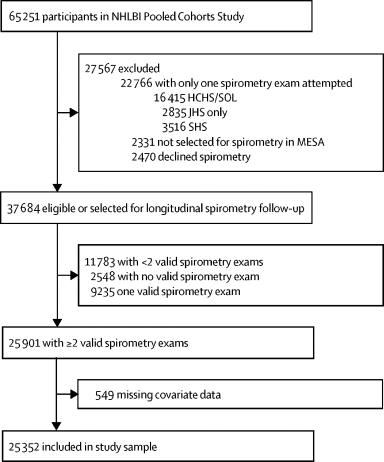The Lancet Respiratory Medicine ( IF 38.7 ) Pub Date : 2019-10-09 , DOI: 10.1016/s2213-2600(19)30276-0 Elizabeth C Oelsner 1 , Pallavi P Balte 1 , Surya P Bhatt 2 , Patricia A Cassano 3 , David Couper 4 , Aaron R Folsom 5 , Neal D Freedman 6 , David R Jacobs 5 , Ravi Kalhan 7 , Amanda R Mathew 8 , Richard A Kronmal 9 , Laura R Loehr 4 , Stephanie J London 10 , Anne B Newman 11 , George T O'Connor 12 , Joseph E Schwartz 1 , Lewis J Smith 7 , Wendy B White 13 , Sachin Yende 11

|
Background
Former smokers now outnumber current smokers in many developed countries, and current smokers are smoking fewer cigarettes per day. Some data suggest that lung function decline normalises with smoking cessation; however, mechanistic studies suggest that lung function decline could continue. We hypothesised that former smokers and low-intensity current smokers have accelerated lung function decline compared with never-smokers, including among those without prevalent lung disease.
Methods
We used data on six US population-based cohorts included in the NHLBI Pooled Cohort Study. We restricted the sample to participants with valid spirometry at two or more exams. Two cohorts recruited younger adults (≥17 years), two recruited middle-aged and older adults (≥45 years), and two recruited only elderly adults (≥65 years) with examinations done between 1983 and 2014. FEV1 decline in sustained former smokers and current smokers was compared to that of never-smokers by use of mixed models adjusted for sociodemographic and anthropometric factors. Differential FEV1 decline was also evaluated according to duration of smoking cessation and cumulative (number of pack-years) and current (number of cigarettes per day) cigarette consumption.
Findings
25 352 participants (ages 17–93 years) completed 70 228 valid spirometry exams. Over a median follow-up of 7 years (IQR 3–20), FEV1 decline at the median age (57 years) was 31·01 mL per year (95% CI 30·66–31·37) in sustained never-smokers, 34·97 mL per year (34·36–35·57) in former smokers, and 39·92 mL per year (38·92–40·92) in current smokers. With adjustment, former smokers showed an accelerated FEV1 decline of 1·82 mL per year (95% CI 1·24–2·40) compared to never-smokers, which was approximately 20% of the effect estimate for current smokers (9·21 mL per year; 95% CI 8·35–10·08). Compared to never-smokers, accelerated FEV1 decline was observed in former smokers for decades after smoking cessation and in current smokers with low cumulative cigarette consumption (<10 pack-years). With respect to current cigarette consumption, the effect estimate for FEV1 decline in current smokers consuming less than five cigarettes per day (7·65 mL per year; 95% CI 6·21–9·09) was 68% of that in current smokers consuming 30 or more cigarettes per day (11·24 mL per year; 9·86–12·62), and around five times greater than in former smokers (1·57 mL per year; 1·00–2·14). Among participants without prevalent lung disease, associations were attenuated but were consistent with the main results.
Interpretation
Former smokers and low-intensity current smokers have accelerated lung function decline compared with never-smokers. These results suggest that all levels of smoking exposure are likely to be associated with lasting and progressive lung damage.
Funding
National Institutes of Health, National Heart Lung and Blood Institute, and US Environmental Protection Agency.
中文翻译:

前吸烟者和低强度当前吸烟者的肺功能下降:NHLBI 汇总队列研究的二次数据分析。
背景
在许多发达国家,前吸烟者的数量现已超过当前吸烟者,而当前吸烟者每天吸烟的数量也减少了。一些数据表明,肺功能下降随着戒烟而恢复正常。然而,机制研究表明肺功能下降可能会继续。我们假设,与从不吸烟者(包括那些没有普遍肺部疾病的人)相比,以前吸烟者和当前低强度吸烟者的肺功能下降速度更快。
方法
我们使用了 NHLBI 联合队列研究中包含的 6 个美国人群的数据。我们将样本限制在两次或多次检查中具有有效肺活量测定的参与者。两个队列招募了年轻成年人(≥17 岁),两个队列招募了中老年人(≥45 岁),两个队列仅招募了老年人(≥65 岁),并在 1983 年至 2014 年间进行了检查。FEV 1持续下降通过使用根据社会人口统计学和人体测量因素进行调整的混合模型,将吸烟者和当前吸烟者与从不吸烟者进行比较。还根据戒烟持续时间和累积(包年数)和当前(每天的香烟数量)吸烟量来评估 FEV 1下降差异。
发现
25 352 名参与者(年龄 17-93 岁)完成了 70 228 次有效的肺量测定检查。在中位随访 7 年 (IQR 3–20) 中,中位年龄 (57 岁) 的 FEV 1下降为每年 31·01 mL (95% CI 30·66–31·37)。吸烟者每年 34·97 mL (34·36–35·57),当前吸烟者每年 39·92 mL (38·92–40·92)。经过调整,与从不吸烟者相比,前吸烟者的 FEV 1每年加速下降 1·82 mL(95% CI 1·24–2·40),大约是当前吸烟者效果估计值的 20%(9 ·每年 21 mL;95% CI 8·35–10·08)。与从不吸烟者相比,前吸烟者在戒烟后几十年内观察到 FEV 1加速下降,而当前吸烟者累计卷烟消费量较低(<10 包年)。就目前的卷烟消费而言,每天消费少于 5 支卷烟(每年 7·65 mL;95% CI 6·21–9·09)的当前吸烟者的 FEV 1下降效果估计为当前吸烟者的 68%。每天吸 30 支或以上香烟的吸烟者(每年 11·24 毫升;9·86–12·62),大约是以前吸烟者的五倍(每年 1·57 毫升;1·00–2·14) 。在没有普遍肺部疾病的参与者中,关联性减弱,但与主要结果一致。
解释
与从不吸烟者相比,曾经吸烟者和低强度当前吸烟者的肺功能下降速度更快。这些结果表明,所有水平的吸烟暴露都可能与持久和进行性肺损伤有关。
资金
美国国立卫生研究院、国家心肺和血液研究所以及美国环境保护署。











































 京公网安备 11010802027423号
京公网安备 11010802027423号